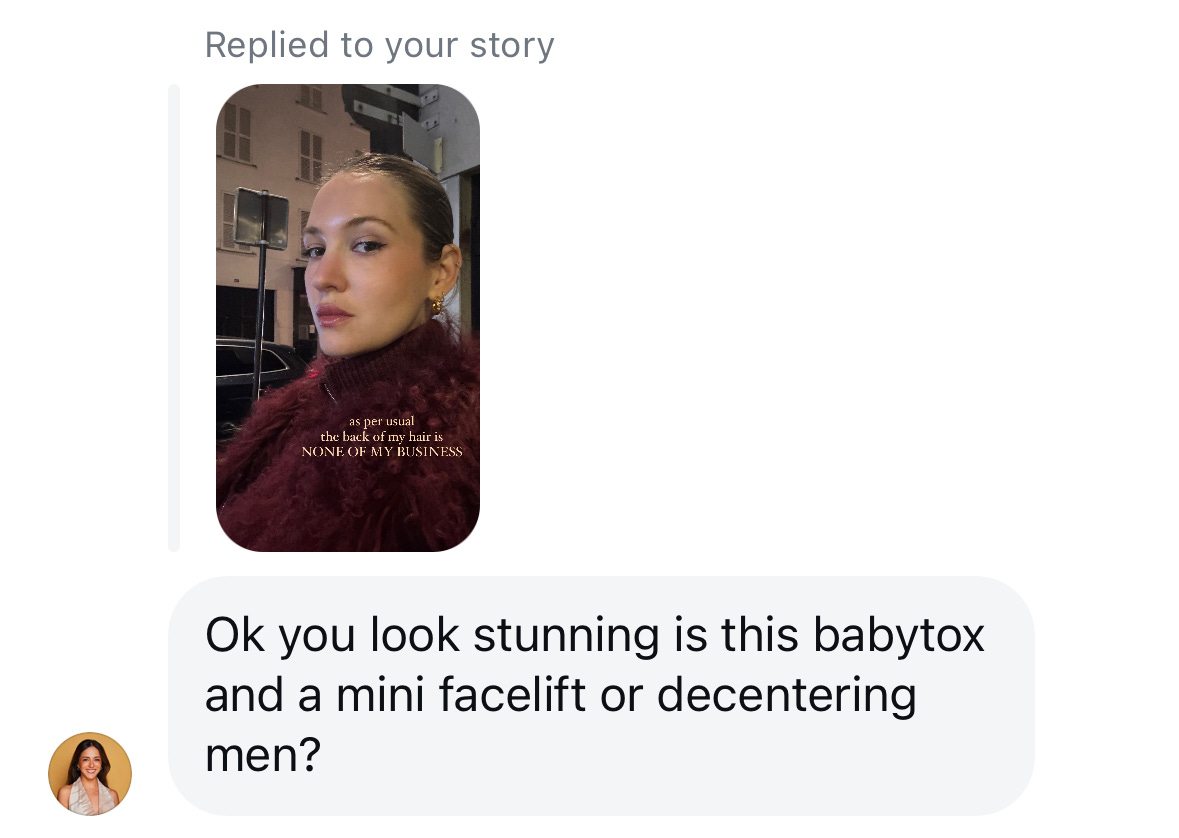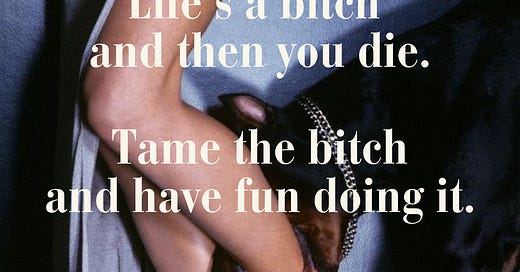Hiiiiiiiiii
I don’t have much to say re: current events except that let’s start by decentering the U.S. from being the be-all and end-all of economy, culture, and politics, okay? Ironically, today’s edition is both more political and more personal than usual. Buckle up!
Elsewhere:
For more personal writing: 5 Cool People, 5 Book Picks. My friend Dagmara invited me to pick a book to read, I went with an underrated classic.
For my French readers: I talked about the business of newsletters to Media Moolah. You can watch the podcast on YouTube or listen to it on Spotify/Apple. I mainly spoke about Magma (my 9-5) but Ronan, the host, surprised me with questions about Oblique Forecasting at the end! I don’t think I had articulated the reasoning behind my imagery before.
xoxo Esther 💋
PS: you know you want to share Oblique Forecasting with your hottest friends so we can all be in this little club together:
Esther’s Buy/Sell List:
💰 What I’m investing in
⏳Smarter aging. At my big age, I’ve been a full legal adult for almost as long as I’ve been a child. Crazy to think about, I know. Now for the million-dollar q: how many more years do I have left?
According to the new-ish app Death Clock, I’ll die at 90. Save the date for 2079! Marketed as ‘AI-Powered Longevity,’ the app blends data from your family background and from your lifestyle habits to determine when you will die, and what choices you could make to extend your lifespan. Unsurprisingly, it was developed in San Francisco by a certain Brent Franson, which places it firmly in the bro-gevity (I made it up, stay with me and we’ll get into it) side of things.
This approach – asking an AI – isn’t typical for someone in my demographic: female, 30s, and financially stable. It is however fairly standard considering my professional circle: start-up/entrepreneur forward, aware of the latest in AI innovation, and… surrounded by men.
—
I hope I’m not blowing anyone’s mind when I say that the approach to ageing is wildly different for men and women.
For a long time, the consensus was that a woman’s prime was somewhere in her 20s/30s, after which she became invisible. Meanwhile, men were allowed to age visibly, with little concern for skincare, UV protection, or any pressure to appear any younger.
I’m getting ahead of myself by talking about appearances. Let’s have a conversation about age first:
Factually, there are more centenarians than ever. 573K worldwide in 2020, almost x4 compared to 2000. Close to 100K live in the U.S. Japan has the highest rate of centenarians, with 0.06% of the population aged 100 or older.
Speaking of Japan, you’ve probably heard of blue zones where people live well past 80: Okinawa/Japan, Ikaria/Greece, Loma Linda/USA, Sardinia/Italy, and Nicoya/Costa Rica.
It’s important to make a distinction between life span (cf #1) and health span or longevity (#2). The former has been increasing steadily in the 20th and 21st century but past a certain age, cancer and dementia rear their ugly heads. That’s where longevity comes in and becomes a keyword (pls refer back to the Death Clock tagline): one can’t push back the inevitable. Instead, the critical issue is making sure you live well: unmedicated, autonomously, in full command of your faculties.
By now, you’ve probably heard of Bryan Johnson, famous for controversial and onerous procedures. The former tech bro created the Blueprint programme (think blue zones + a pattern you can follow), the ultimate marketing of longevity. As a writer dabbling in branding, I can only applaud the sheer hubris of his tagline: “Don’t die.” You can buy supplements, olive oil and immortality-core merch on his website.
This approach strikes me because I had started to view ageing as the better option: “Do not regret growing older. It is a privilege denied to many.” You can either embrace your age or die.
I met a few founders in the longevity space here in Paris: the market is ripe for the taking, growing from $25 B in 2020 to $44 B in 2030 worldwide. Another leading man in this industry is Andrew Huberman – I’ve talked about him here – who calls it biohacking. Which is less about preventing death and instead about upgrading one’s lifestyle to enhance performance. Think: protein/fibre intake, cardio/weightlifting ratio, UV exposure, ice baths.
I may be taking a shortcut but the way men (who dominate the longevity/biohacking space) approach this is mostly about tracking data. Everyone owns an Apple Watch, a Whoop or an OURA ring, myself included. Sleeping, walking and working out are turned into numbers one can crunch and perpetually improve on. A longevity club I’m loosely a part of publishes a monthly dashboard, turning health into a competition. What’s the grand prize? Unclear, and it’s certainly not not dying.
Is the end goal enhanced masculinity? Should we ask Mark Zuckerberg?
—
The conversation around ageing seems to be more superficial – skin deep? – when targeted towards women.
Anti-ageing creams have been marketed to women for decades. A quick aside: I’ve always been aware that beauty companies sell snake oil, and the effectiveness of their products is questionable. The belief was solidified when I befriended one of the faces of a major skincare brand advertising an anti-wrinkles cream when she was in her late 20s.
The argument I’m seeing is that no matter how good she feels inside and how her healthy her medical results are, a woman must project at least the facade of eternal youth. Or is it fertility?
No need to track data when others can observe the absence of wrinkles, white hair or any sign of sagginess.
The pressure isn’t new, but it has increased steadily with the improvement of picture quality with every new iPhone release, and the popularisation of non-surgical enhancements like Botox and fillers. It’s hard to remember now, but there was a time when you went to the dermatologist for skin diseases, not for a fresh syringe.
The conversation about ageing has also changed in the past few years because wrinkle prevention used to start later, with less invasive procedures. Girls in their 20s turning to “preventative Botox” or babytox inadvertently age themselves since we associate the frozen and overfilled look with older women.

I’m not trying to turn my personal experience into a generality but I have mixed feelings about the way I’m being talked to about my age and my face. Is it because I post selfies/appear in video podcasts that others feel entitled to express their opinion? Is it simply because I’m a woman? Either way, whenever I meet a new person, usually a Gen Zer, they make a great fuss when they learn my age. Unbelievable. What’s your secret? It’s of course flattering in the sense that it validates my skincare/lifestyle, even though I would credit good genes in there too. But the subtext is invariably: how do you present so young when you’re so old in reality?
—
As always, when the pendulum swings hard one way, the other way must prevail sooner or later. A paradigm shift is underway. For a few months, we’ve been uncovering undetectable plastic surgery. Influencers are dissolving their filler. Self-proclaimed low-maintenance women view themselves as more virtuous for not succumbing to the pressure—a form of pressure in itself because we’re now supposed to look a certain way naturally, but that’s a conversation for another day.
Presenting as naturally youthful and flawless is another side of the traditional gender role coin. When men embrace this new era of “MMA-politics” by emulating alpha males, women lose agency over their bodies and are relegated to the subservient tradwife cliché.
tl;dr
men care about ageing from a functional point of view and try to prevent the inevitable.
women are made to care about ageing by internalising how young and desirable they’re being perceived.
Both approaches fail to address a universal truth: ageing is inevitable, but living well is a choice.
—
Companies prey on both genders’ insecurities to sell the missing piece. If I were to launch a product today, be it skincare, a supplement, fitness equipment or services, I’d aim to create something that celebrates the privilege of growing older.
Longevity isn’t just about appearance or numbers, it’s about how people feel physically, emotionally, and socially. Brands can create platforms or events that bring people together to share their journeys, making them feel supported rather than isolated or pitted against one another (e.g. the longevity club dashboard) in their experiences.
Recognise that both men and women share the same fundamental desire: to live fully and well. Products that cater to shared aspirations rather than reinforcing stereotypes will resonate more broadly.
Esther’s Dealsheet:
📈 Bullish news
TIKTOK IS NOT BANNED AFTER ALL?!
Meta, Google biggest winners from TikTok ban[Axios]. Instagram and Facebook would take 22.% and 17.1% of TikTok's reallocated ad spend, respectively. Google's YouTube would take roughly 10.7%. Other social media platforms, like Snapchat, LinkedIn, Pinterest, Reddit and X, would collectively take roughly 18.3% of reallocated TikTok ad spend.‘Red Note,’ a Chinese App, Is Dominating Downloads, Thanks to TikTok Users [NYT]. Let’s see if the trend keeps gaining traction and I’ll admitI was wrong!A Sofia Coppola hotel in the works? [Elle US] A girl (me) can dream.
Kering Seals Private Equity Deal With Ardian for Place Vendôme, Avenue Montaigne Real Estate [WWD]. A casual €837M deal.
Estée Lauder plans to dominate the $24 B global home fragrance market with Exuud, a new technology designed to prevent our noses from becoming desensitized to scents. [Fast Company]
Raspberry AI, a design platform that adapts AI’s image-generating capabilities to the needs of fashion creatives, announced $24 M funding from investors including Andreessen Horowitz, Greycroft, MVP Ventures, and Correlation Ventures. The startup had recently raised a $4.5 M round last year. [BOF]
GQ and Bode to Host Super Bowl Fashion Show [BOF]. The fashion x sports crossover is getting realer and realer.
Parents Are Gaming Their Kids’ Credit Scores [The Atlantic]
Eli Lilly, Andreessen Horowitz link up on $500M biotech venture fund [Fierce Biotech]
7 global buzzwords for 2025: From 'techquity' to 'climate displacement' to 'belonging' [npr]
This week’s fashion musical chairs: Jack McCollough and Lazaro Hernandez are leaving their label Proenza Schouler. [WWD] Every sign seems to point towards them leading Loewe following Jonathan Anderson’s departure.
Richemont Sales up 10% in Q3 2024, with Strong Gains Worldwide, Except China [yahoo! Finance]
📉 Bearish news
Sonos CEO Patrick Spence steps down after disastrous app launch [the Verge]
Goldman Sachs’ C.E.O. David Solomon told FT that A.I. can now draft 95% of an I.P.O. prospectus in minutes—a job that once required a six-person team two weeks. [FT]
AI Financial Advisers Target Young People Living Paycheck to Paycheck [Wired] Hint: it’s a scam.
Kayak founder returns with Steppin, an app that locks you out of social media until you go for a walk [TechCrunch]. Joke’s on him, I have an insane screen time AND I manage to hit my daily 10k steps.
Meta plans to cut 5% of its workforce, focusing on the lowest performers. [BI]
A top banker told FT, “I feel liberated. We can say ‘r***rd’ and ‘p**sy’ without the fear of getting cancelled . . . it’s a new dawn.” [FT] Is this the masculine energy Zucky wants to bring back to corporations?
Inside the Chinese factories fuelling Shein's success [BBC]
Apple has worst day since August following reports of China, AI struggles [CNBC]
The great non-alcoholic rip-off: why a booze-free drink costs as much as a pint [The Telegraph]







Loved this so much have been thinking about it all day - btw, on blue zones - did you hear about the hypothesis these are fake and have to do with pension fraud and poor data keeping mostly? I’m skeptical but interesting nonetheless